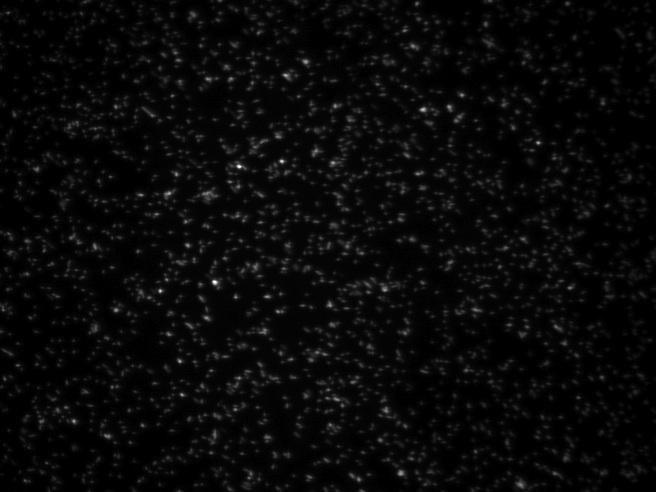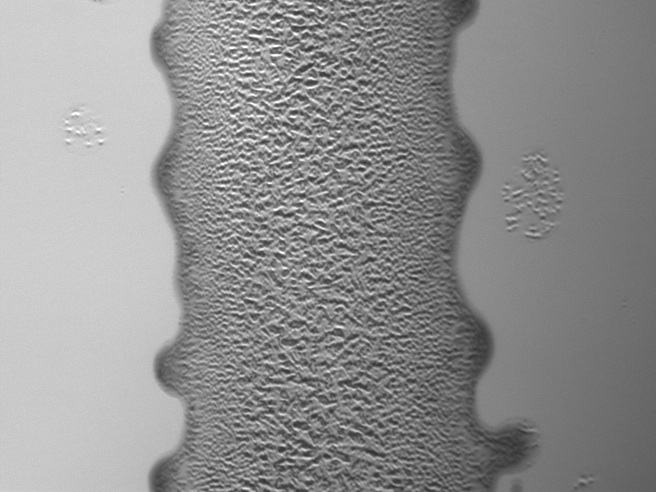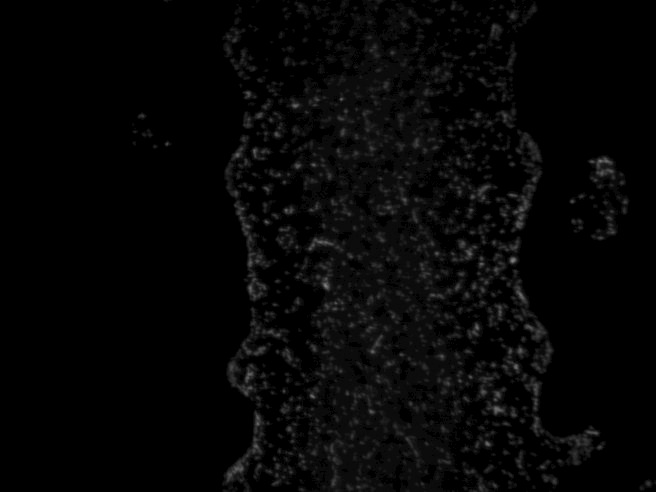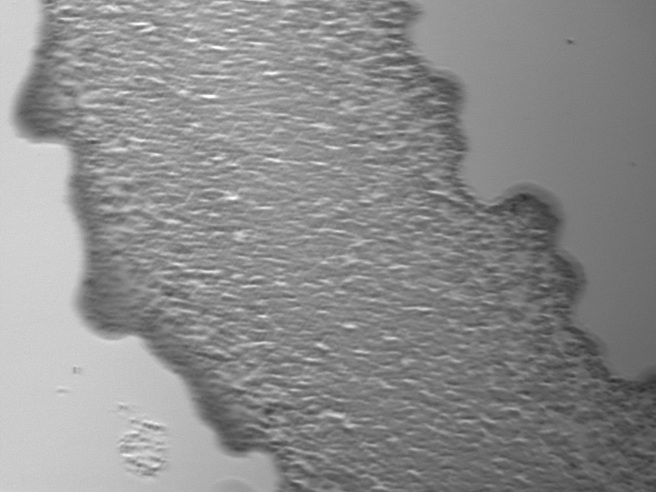Difference between revisions of "Cell Printing Experimentation"
(Created page with "Once cartridge experimentation was completed, the next step was to try the device on cells themselves. For cell solution, I used RFP-expressing and GFP-expressing E. coli, gro...") |
|||
| Line 9: | Line 9: | ||
'''Design''' The experimental design for this was quite simple--load the black ink cartridge with 0.5 mL of RFP E. coli and print onto a microscope slide. | '''Design''' The experimental design for this was quite simple--load the black ink cartridge with 0.5 mL of RFP E. coli and print onto a microscope slide. | ||
| − | '''Result''' The cells did in fact print and they could be visualized in the defined pattern | + | '''Result''' The cells did in fact print and they could be visualized in the defined pattern! However, the cells' fluorescence was fairly dim, making it hard to distinguish what was actually a cell and what was fluorescence from the solution that had also been transferred to the slide. |
| + | |||
| + | [[File:RFPecoli.jpg]] | ||
| + | |||
| + | ''E. Coli at a concentration of 10^8 cells/mL (not printed)" | ||
| + | |||
| + | |||
| + | [[File:printed1b.jpg]] | ||
| + | |||
| + | [[File:printed1f.jpg]] | ||
| + | |||
| + | ''RFP E. coli imaged in brightfield and fluorescence - A defined pattern of E. coli is distinguishable, as seen in this image of one bar of an equals sign'' | ||
| + | |||
| + | |||
| + | ===='''Experiment 2: Viability'''==== | ||
| + | |||
| + | '''Key Question''' Are the cells able to grow after being printed? | ||
| + | |||
| + | '''Design''' After being printed, RFP E. coli were incubated in a humid chamber created by a vacuum grease seal and a second cover slip. After 30 minutes, the cover slip was removed and the sample was placed in a petri dish, at which point broth was added. The sample incubated at 37 degrees C for 24 hours. | ||
| + | |||
| + | '''Results''' Though fluorescence was still visibly patterned after 24 hours, it was hard to determine whether the cells had grown dramatically. Fluorescence was still fairly weak and a bit spotty, and individual cells were hard to distinguish. This may have been that the samples were allowed to dry out too much before adding the broth, meaning less overall growth was seen. | ||
| + | |||
| + | |||
| + | [[File:printed2b.jpg]] | ||
| + | |||
| + | [[File:printed2f.jpg]] | ||
| + | |||
| + | ''RFP E. coli imaged in brightfield and fluorescence after 24 hours in broth'' | ||
| + | |||
| + | |||
| + | ===='''Experiment 3: Two-sample printing'''==== | ||
| + | |||
| + | '''Key Question''' Can two types of cells be printed in defined and integrated patterns? | ||
| + | |||
| + | '''Design''' The color cartridge was cleaned and the cyan channel was loaded with GFP-expressing cells, whereas the black cartridge was filled with RFP-expressing cells. The two were printed in the pattern seen below. Remember that lines that appear black should fluoresce red and lines that appear blue should fluoresce green. | ||
| + | |||
| + | [[File:20345.jpg]] | ||
| + | |||
| + | '''Results''' Both red and green could be seen on the two-channel microscope in the 20.109 lab. However, due to time constraints and limits on equipment availability, clear cells were never able to be seen and imaged in two colors. | ||
Revision as of 12:46, 19 May 2011
Once cartridge experimentation was completed, the next step was to try the device on cells themselves.
For cell solution, I used RFP-expressing and GFP-expressing E. coli, grown in L-broth to an approximate density of 10^8 cells/mL. This concentration equates to approximately 6 cells/droplet.
Experiment 1: Basic printing
Key Question Can cells be seen after the solution is printed?
Design The experimental design for this was quite simple--load the black ink cartridge with 0.5 mL of RFP E. coli and print onto a microscope slide.
Result The cells did in fact print and they could be visualized in the defined pattern! However, the cells' fluorescence was fairly dim, making it hard to distinguish what was actually a cell and what was fluorescence from the solution that had also been transferred to the slide.
E. Coli at a concentration of 10^8 cells/mL (not printed)"
RFP E. coli imaged in brightfield and fluorescence - A defined pattern of E. coli is distinguishable, as seen in this image of one bar of an equals sign
Experiment 2: Viability
Key Question Are the cells able to grow after being printed?
Design After being printed, RFP E. coli were incubated in a humid chamber created by a vacuum grease seal and a second cover slip. After 30 minutes, the cover slip was removed and the sample was placed in a petri dish, at which point broth was added. The sample incubated at 37 degrees C for 24 hours.
Results Though fluorescence was still visibly patterned after 24 hours, it was hard to determine whether the cells had grown dramatically. Fluorescence was still fairly weak and a bit spotty, and individual cells were hard to distinguish. This may have been that the samples were allowed to dry out too much before adding the broth, meaning less overall growth was seen.
RFP E. coli imaged in brightfield and fluorescence after 24 hours in broth
Experiment 3: Two-sample printing
Key Question Can two types of cells be printed in defined and integrated patterns?
Design The color cartridge was cleaned and the cyan channel was loaded with GFP-expressing cells, whereas the black cartridge was filled with RFP-expressing cells. The two were printed in the pattern seen below. Remember that lines that appear black should fluoresce red and lines that appear blue should fluoresce green.
Results Both red and green could be seen on the two-channel microscope in the 20.109 lab. However, due to time constraints and limits on equipment availability, clear cells were never able to be seen and imaged in two colors.





